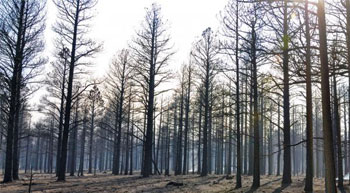While humans bicker over whether climate change is happening, animals and plants aren’t waiting around. They are moving to completely new habitats if they can.
Take the Gulf of Maine, where the economy depends on lobsters. Warming almost 100% faster than the ocean, the gulf has been unusually flooded with lobsters for the past 7 years after they moved north from Long Island. But like cod, herring and northern shrimp, lobster populations could well leave for colder waters, and there’s evidence that’s beginning to happen.
Maybe fisherman will turn to catching black sea bass, blue crabs and squid that are coming up from the south.
"These changes are very real, and we’re seeing them happen quickly," Malin Pinsky, a biology professor at Rutgers University told Associated Press.
No more Maine lobster or Chesapeake blue crab?
Gulf of Maine temperatures are rising quickly now, accelerating by 0.5 degree F a year – 10 times faster than in 1982, says Andy Pershing, chief scientific officer at Gulf of Maine Research Institute. Temperatures are expected to rise more than 4 degrees F by 2100 there, he told Associated Press.
Historically, one of the most productive marine ecosystems in the world, it is losing half the 36 fish stocks
studied there. That, of course, effects the rest of the food chain. Puffin chicks are starving because the herring and hake they depend on are gone.
Moving Forests
The Nature Conservancy (TNC) is restoring forests in northern Minnesota, but they are not planting native trees. Instead, they are planting red and bur oak, which typically grow 200 miles to the south and white pine from as far as 400 miles away in southern Michigan.
Why? Because the climate is changing, with warmer and potentially drier conditions expected in the north. Boreal species such as white spruce, balsam fir and paper birch that currently dominate the forest will no longer be able to live there, but it will be suitable for oaks and other species.
"Our goal is to maintain a forest going forward," Meredith Cornett of TNC, told ClimateCentral. "We run the risk of losing forest cover because we don’t have a suite of species that are resilient to climate change – they won’t be able to hang in there or keep pace with the rate of climate change."
The question is how to help plants that are rooted in one place find new homes as the climate shifts. Strategies include "assisted gene flow," where species are moved within their current range, and "assisted migration" where people help them expand outside their native range, reports ClimateCentral.
For example, an endangered conifer, Torreya taxifolia, has been moved from its native Florida to sites in North Carolina.
When glaciers retreated 10,000 years ago, the fastest moving trees covered barren ground by moving 100-200 yards a year, but now the climate is shifting north up to 4 miles per year, Sally Aitken, director of the Centre for Forest Conservation Genetics at University of British Columbia, told ClimateCentral. The fear is that many trees will die off, greatly reducing diversity and thus, healthy ecosystems.
But scientists aren’t sure there won’t be negative effects from mixing in species from other ecosystems. Could they become invasive, for example?
Forests in the Rockies are being devastated by climate change (higher temperatures, extensive drought) from a combination of wildfires and bark beetles that no longer die off in the winter. Beetles killed 46 million acres of trees from 2000-2012, an area nearly the size of Colorado.

Half of all Whitebark pines are dead or dying. This hardy tree – which can live for 1000 years – is now Canada’s Endangered Species list and is a candidate for listing in the US. Besides the insects, a fungus is attacking them, and fire suppression efforts prevent seedlings from taking hold. Over 100 animal species depend on them for food and shelter, such as bears and birds.
Assisted migration for whitebark pines is complicated because they would also have to move Clark’s nutcracker – the only bird that spreads their seeds. Instead, scientists are looking at moving trees in the southern part of their range to northern parts, where they might thrive in a warmer climate.
Pinon, Lodgepole and Ponderosa pine, Aspens and other cool weather species are also in grave danger, according to "Rocky Mountain Forests at Risk," by the Union of Concerned Scientists and Rocky Mountain Climate Organization.
On the other hand, some trees are growing much faster than normal. Beech, for example, is growing 77% faster than in the 1960s, because there’s more carbon and nitrogen (from car emissions) in the atmosphere, according to research at Technical University in Munich.
Read our article, Scientists Map Speed of Climate Change.
Read the report (or the summary), Rocky Mountain Forests at Risk:
